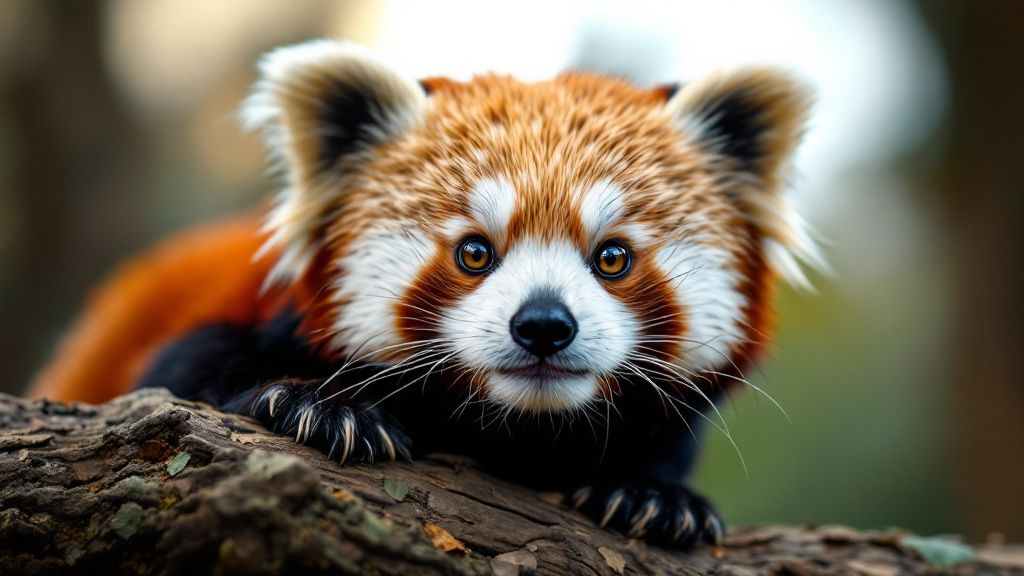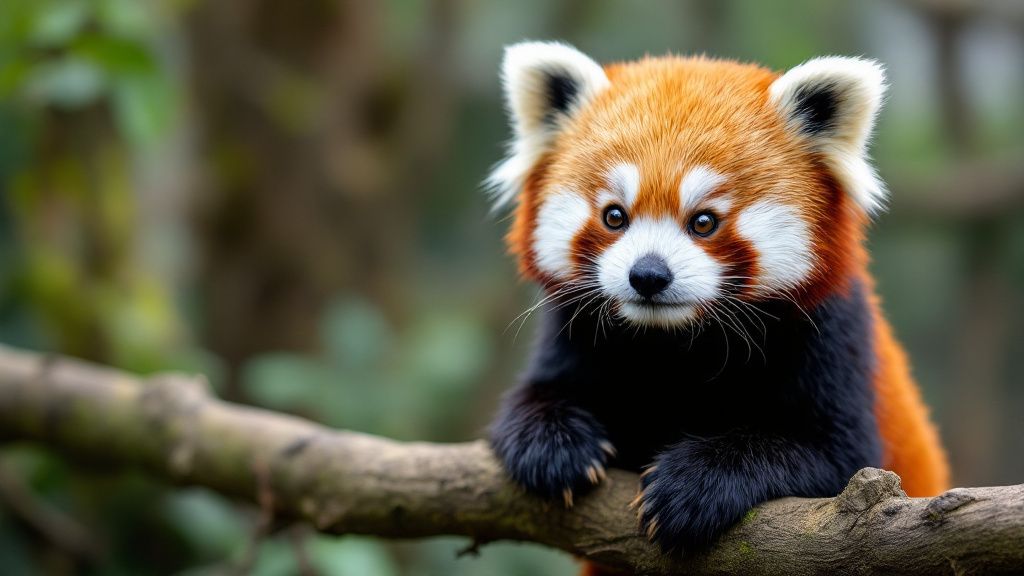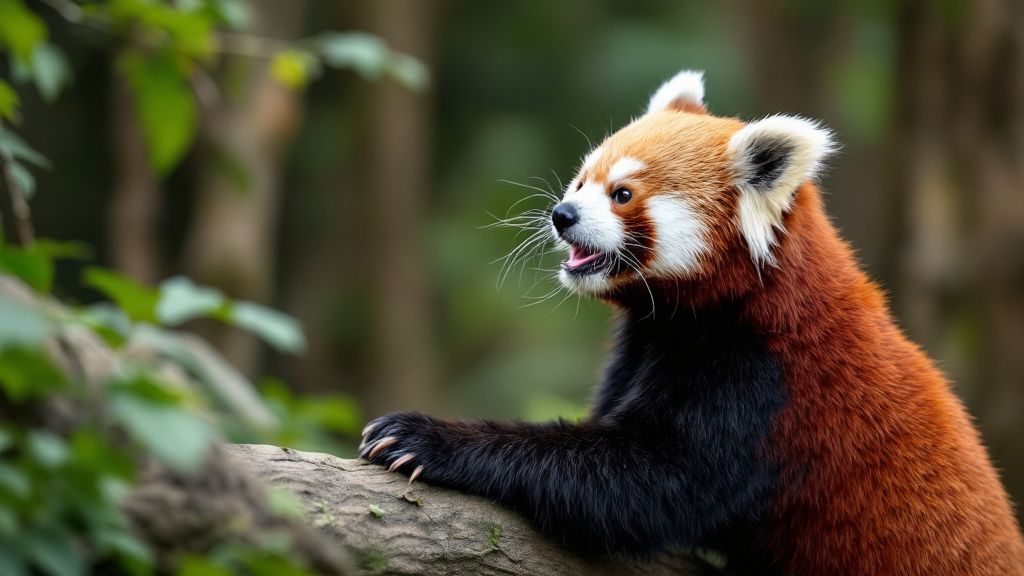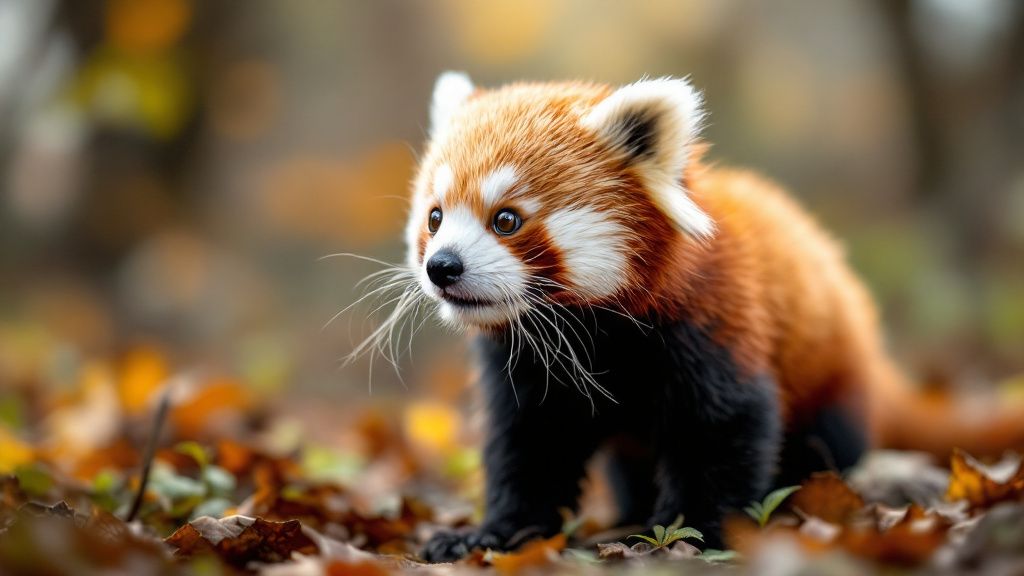
The red panda, often overshadowed by its more famous namesake neighbor, the giant panda, is a captivating example of unusual animal behavior and unique animal adaptations. Despite its striking reddish-brown fur and bushy, ringed tail, which endears it to many, the red panda is an endangered species, primarily due to habitat loss and fragmentation. As a fascinating carnivore, it is a member of the order Carnivora, yet its diet is mostly herbivorous. Bamboo constitutes the majority of its intake, demonstrating an intriguing culinary preference among carnivores.
This arboreal mammal, native to the Eastern Himalayas and southwestern China, showcases remarkable adaptations that aid in its survival. Its semi-retractable claws, ideal for gripping tree branches, and the lack of a functional thumb promote efficient climbing and foraging efforts, revealing a history of diverse evolutionary paths. While it shares dietary similarities with the giant panda, it is not closely related, and this is a common misconception in the animal discovery field.
Furthermore, the red panda's social structure is characterized by solitary behavior, a trait typical of many unique wildlife species, arising from its need to conserve resources in sparse environments. Breeding may occur between January and March, and the resulting offspring remain with the mother for a significant time, emphasizing strong parental investment common amongst rare animals.
Incorporating the red panda into educational and conservational efforts has become a focal point for animal rights organizations. These initiatives often aim to raise awareness about this species’ plight and promote the ethical treatment and salvation of unique wildlife. For those enticed by the idea of exotic pets, it is crucial to understand the implications of such actions on animal conservation efforts and why buying exotic animals can exacerbate the challenges faced by uncommon pets.
Understanding and appreciating the intricate life of the red panda contributes to broader animal conservation goals and highlights the importance of supporting organizations dedicated to the preservation of strange animals. Such efforts enrich the world’s biodiversity and ensure that the red panda, with its peculiar ways and charm, does not vanish from our planet's unique animals list.

The way society views carnivores has evolved significantly over time. Traditionally seen as apex predators with a voracious appetite for other animals, contemporary understanding paints a more nuanced picture of these creatures. This paradigm shift acknowledges the vital role that carnivores play within ecosystems and emphasizes their importance beyond mere predation. Public fascination has soared, and these once-feared creatures are frequently highlighted in animal discovery programs, which seek to educate the public on their ecological significance.
By recognizing carnivores' various ecological roles, from controlling prey populations to aiding in seed dispersal, we gain insights into the complex networks that define unique wildlife habitats. This evolved perception fosters a growing interest in protecting rare animals and supports the efforts of animal conservationists. It becomes clearer that every species has a place in maintaining biodiversity, whether through unique animal adaptations or contributing to balanced ecosystems.
Amid growing awareness, animal rights organizations work tirelessly to foster understanding and dispel myths surrounding carnivores. These groups provide educational resources and promote the idea that these animals are as essential as they are fascinating. They guide efforts towards saving endangered species and advocate against the capture and trade of weird animal species for exotic pets. Such initiatives work to ensure that uncommon pets like the red panda and other lesser-known carnivores are preserved in the wild.
Organizations dedicated to broad animal research fuel this change in perception. They offer platforms for engagement, where eco-conscious consumers can support initiatives that protect unique animal species. Through increased awareness, sustainable practices surrounding the curiosity to buy exotic animals are being reinforced. Understanding the intrinsic value these creatures bring to the natural world encourages a broader appreciation for preserving unique animal facts and stories for generations to come.

Caring for unique pets, ranging from the exotic to the downright bizarre, requires dedication and an understanding of their distinct needs. These rare animals often come with specific care requirements that differ significantly from more common household pets. Given their unique animal adaptations, it is crucial to create an environment that closely mimics their natural habitat, ensuring they exhibit the best of their unusual animal behavior.
First and foremost, nutrition is a vital aspect of caring for uncommon pets. Many exotic pets have specialized dietary needs that must be met to maintain their health. For instance, reptiles may require live insects, while some exotic birds benefit from a varied diet of fruits, seeds, and nuts. Understanding these needs can prevent malnutrition and health issues, promoting longevity and vibrancy in your pet.
Temperature and habitat control are equally important. Many strange animals hail from specific climates, and pet owners must regulate temperature and humidity levels to align with the animal’s natural environment. Appropriate enclosures equipped with UV lighting, heat sources, or water features can help achieve this balance, ensuring the pet remains happy and healthy.
Social interaction and enrichment play significant roles in the well-being of unique pets. Providing opportunities for interaction, mental stimulation, and physical exercise helps in reducing stress and promoting natural behaviors. Incorporating toys, climbing structures, or spaces for digging and exploration can make a significant difference in the quality of life for these animals.
Given the unique nature of these pets, consulting with veterinarians specialized in exotic animals is advisable. They can provide valuable insights into health checks, vaccination schedules, and preventative care tailored to unique wildlife species. Professional guidance ensures that you are equipped to foresee and address any potential health concerns that may arise.
As awareness grows around ethical practices concerning rare animals, companies like Eco-Pet Habitats are at the forefront, providing sustainable and customizable enclosure solutions tailored to a pet's specific environmental needs. By investing in such resources, you not only cater to the peculiar requirements of your uncommon pets but also contribute to a greater movement that champions responsible pet ownership and animal welfare.
It's a rewarding journey that requires commitment and love, but with the right knowledge and resources, caring for a unique pet can be a fulfilling experience as you contribute to an appreciation for diversity within the animal kingdom.

Conserving uncommon species presents a unique set of challenges that require innovative solutions. These rare animals often inhabit specialized ecosystems that are under threat from human activities, such as deforestation, urbanization, and climate change. The loss of habitat not only diminishes the available space for these creatures but also disrupts the ecological balance that sustains them.
One of the primary challenges in animal conservation is the lack of public awareness about the significance of protecting strange animals and their habitats. Many people are oblivious to the existence of these species and the critical roles they play in the environment. This gap in knowledge makes it challenging for animal rights organizations to garner the support needed for effective conservation measures.
Illegal wildlife trade exacerbates the plight of uncommon pets. The demand to buy exotic animals drives poaching and illegal trafficking, further endangering species that are already vulnerable. Addressing this issue involves tightening international regulations and increasing patrol efforts to deter poachers and illegal traders.
Successful conservation strategies often focus on habitat restoration and protection. Reestablishing native vegetation and creating protected areas can provide the necessary sanctuary for unique wildlife populations to flourish. Community involvement in these initiatives is crucial. Encouraging local communities to participate in conservation efforts not only enhances the sustainability of such programs but also generates economic benefits through eco-tourism and sustainable resource management.
Education and advocacy play an essential role in shifting perceptions and promoting the importance of conserving unique animal species. By collaborating with educational institutions, conservation groups can develop programs that teach the value of biodiversity and the need for preservation. Schools and universities can create curricula that focus on unique animal facts, instilling appreciation from a young age.
Incorporating technology into conservation efforts offers additional solutions. Tracking systems, such as GPS collars and drones, can monitor animal movements and detect habitat changes in real time. This data helps conservationists make informed decisions and adapt strategies to ensure the well-being of these animals.
Companies like GreenVision Wildlife Solutions are pioneering technological advances to aid conservationists in their mission. Through their innovative monitoring tools and expertise in habitat restoration, they provide invaluable support in the global effort to protect diverse species.
By addressing the challenges and implementing comprehensive solutions, we can make significant strides in preserving the diverse tapestry of life on Earth, allowing future generations to marvel at the wonder of rare and unique animals.

The allure of keeping exotic pets often masks the complex ethical, environmental, and logistical issues entwined with this practice. One primary argument against keeping unusual animals as pets centers on the welfare challenges these creatures face outside their natural habitats. Many rare animals possess specialized needs that are difficult to meet in a domestic setting, leading to compromised health and well-being.
Health risks also arise, both for the animals and their human caretakers. Many exotic species carry zoonotic diseases, which can transfer from animals to humans, posing significant health threats. To mitigate these risks, it is crucial to involve veterinary professionals who specialize in exotic pets, ensuring that both the pet's and owner's health are safeguarded.
Environmental impact represents another compelling counterpoint. The demand to buy exotic animals contributes to illegal wildlife trade, thereby speeding up the decline of already endangered species. Capturing animals from the wild disrupts ecosystems and threatens biodiversity, underscoring the importance of animal conservation efforts. Awareness campaigns aim to educate the public on the consequences of removing animals from their natural environments, advocating for the preservation of unique wildlife.
Moreover, ethical considerations revolve around the rights of animals to lead lives free from undue confinement and stress. Animal rights organizations argue that keeping exotic pets often results in psychological and physical stress for these creatures, who find themselves in foreign environments far removed from their instinctual norms. Engaging with organizations dedicated to animal rights helps to promote the ideology that wild animals are best appreciated in their natural settings rather than in domestic spaces.
While some pet owners believe they can provide adequate care for uncommon pets, it’s essential to consider whether their actions contribute to a larger problem. Instead, supporting businesses and initiatives like WildLife Connections can offer a path forward. WildLife Connections fosters programs for wildlife preservation and education, spotlighting the critical role individuals can play in protecting the planet's rich array of species without confining them to a life outside their inherent place in nature.
Through comprehensive understanding and responsible choices, society can ensure that unique animal species remain integral to the wild landscapes they belong to, admired from afar without compromising their freedom or existence.

The future of red panda conservation hinges upon innovative strategies and concerted global efforts to mitigate the challenges threatening this captivating species. As a critically endangered species, red pandas face significant risks from habitat destruction, climate change, and poaching, all of which threaten their survival in the wild.
One of the essential components in advancing red panda conservation is the implementation of effective habitat protection measures. Preserving and restoring their natural habitats in the Eastern Himalayas is vital. This involves collaborating with local communities to promote sustainable land use and creating protected areas that support healthy ecosystems.
Public education and awareness play a crucial role in supporting these efforts. Increasing knowledge about the plight of the red panda and its environmental significance can inspire individuals to participate in conservation activities. Schools, zoos, and conservation programs can integrate unique animal facts about red pandas into their curriculums and exhibits, fostering a deeper appreciation for these extraordinary creatures and encouraging a commitment to animal rights organizations.
Technological advancements provide additional pathways for conservation success. Drones and camera traps, for instance, offer innovative methods to monitor red panda populations, track their movements, and assess habitat conditions. This real-time data collection helps conservationists to refine their strategies effectively.
Financial and institutional support is equally important. Engaging with businesses like Wild Haven Conservation Solutions, which develop sustainable initiatives and invest in wildlife protection, can provide the resources necessary for long-term conservation success. By facilitating partnerships between private entities and conservation groups, these efforts drive impactful actions that safeguard the red panda's future.
In addition to direct conservation activities, combating illegal poaching through stricter enforcement and community-based anti-poaching campaigns is critical. Empowering local communities with the tools and education needed to protect wildlife reduces the incentive for illegal wildlife trade, thereby decreasing the threats to red pandas and other unique wildlife.
In looking to the future, it’s evident that conserving the red panda requires a multifaceted approach that blends habitat protection, education, technological innovation, and community engagement. By focusing collective efforts on preserving these uncommon pets within their natural habitats, we can help ensure that red pandas continue to thrive, captivating the hearts and minds of future generations with their unique charm and behaviors.

Analyzing the current trends in wildlife conservation reveals a dynamic landscape shaped by technological advancements, increased global awareness, and strategic collaborations. These trends reflect a growing recognition of the importance of preserving unique wildlife and addressing the dire threats they face.
One notable trend is the utilization of technology in conservation efforts. Tools such as satellite imaging, drones, and GPS tracking are now instrumental in monitoring animal populations and understanding their behaviors. These technologies allow conservationists to gather detailed data on the movements and health of rare animals, enabling more targeted and effective conservation strategies.
Public awareness and education have become central to modern conservation efforts. There is a significant push towards integrating wildlife education into school curriculums and public exhibits, which emphasizes unique animal facts and the ecological importance of preserving biodiversity. By educating younger generations, conservationists aim to instill a lasting commitment to safeguarding unusual animals and their habitats.
Another trend is the emphasis on community involvement. Grassroots initiatives and community-based conservation projects empower local populations to play a direct role in protecting their native species. This approach not only enhances conservation effectiveness but also brings economic benefits through eco-tourism and sustainable practices, creating a symbiotic relationship between wildlife protection and community development.
Additionally, conservation efforts are increasingly focusing on policy advocacy and international partnerships. Global cooperation is crucial in addressing issues such as climate change and illegal wildlife trade, which know no borders and affect numerous species internationally. Organizations working collaboratively ensure that conservation policies are implemented on a broader scale, offering a unified approach to tackling these global challenges.
Businesses such as Earthwise Conservation Enterprises are capitalizing on these trends by investing in sustainable practices and supporting projects aimed at preserving unique wildlife. Their involvement exemplifies how corporate responsibility can positively impact wildlife conservation efforts, driving change through funding, technology, and advocacy.
The analysis of wildlife conservation trends underscores a shift towards holistic and inclusive approaches. By integrating technological innovation, community engagement, educational outreach, and policy collaboration, the conservation landscape is evolving to better meet the needs of endangered species and the challenges they face. This comprehensive approach ensures that animal conservation remains a dynamic and impactful field, poised to address current and future conservation needs effectively.
Get free resources, early access to new features and updates.
No spam. Just fun educational emails!